
Introduced in 1967, the Pontiac Firebird quickly ascended to icon status among American muscle cars, admired for its robust power, compelling style, and thrilling performance. Over its three-year first generation from 1967 to 1969, the Firebird set a new benchmark in the automotive industry, blending sportiness with innovation.
This article explores the origins, features, and legacy of the first generation Firebird, which set a new standard in the automotive industry during its brief three-year run from 1967 to 1969.
Introduction to the Pontiac Firebird
The Pontiac Firebird was born out of a desire to compete with the Ford Mustang, which had captured the imagination of the American public. General Motors responded with not one, but two models: the Chevrolet Camaro and the Pontiac Firebird.
Although they shared the same F-body platform, each brand offered unique styling cues and performance features that helped them stand apart in the burgeoning muscle car market.
Design and Styling

Exterior Features
The first-generation Firebird’s design was noted for its aggressive lines and a front-end characterized by a split grille, inspired by Pontiac’s GTO. The car featured coke-bottle styling typical of the era, with a rear stance that was both wide and muscular. It was available in both hardtop and convertible models, appealing to a broad audience who sought both performance and style.
Interior Layout
Inside, the Firebird offered a driver-focused cockpit, which was designed to enhance the driving experience. Features included bucket seats, a sporty steering wheel, and an optional center console. Instrumentation was comprehensive for its time, with gauges that included a tachometer, speedometer, and various other engine-related readouts.
Engine and Performance

Engine Options
From its inception, the Firebird was available with a variety of engines, allowing buyers to customize their vehicle’s performance:
- The Overhead Cam Six (OHC-6): This 230 cubic inch (3.8 liter) six-cylinder engine was a novelty in the muscle car world, designed for those who wanted a blend of performance and fuel efficiency.
- The 326 V8: A step up from the six-cylinder, this engine offered a more robust performance, making it a popular choice among enthusiasts.
- The 400 V8: At the top of the engine range, this 400 cubic inch (6.6 liter) V8 engine delivered the true muscle car experience, featuring high power output and a thunderous roar that became synonymous with American muscle cars.
Transmission Choices
The Firebird was offered with both manual and automatic transmissions, including a three-speed manual, four-speed manual, and a two-speed automatic. These options allowed drivers to choose a driving style that best suited their preferences, whether it was laid-back cruising or high-performance driving.
Special Models and Packages

Firebird Sprint
The Firebird Sprint was a performance version of the OHC-6, featuring a four-barrel carburetor that boosted its power to 215 horsepower. It was marketed towards those who wanted a more dynamic driving experience but preferred a six-cylinder engine.
Firebird HO (High Output)
The Firebird High Output (HO) models were equipped with the 326 V8 engine, which was tuned to produce more power. This model also featured upgrades such as a dual exhaust system, improving both performance and the vehicle’s sound.
Firebird 400
The Firebird 400 was the epitome of muscle car performance in the Firebird range. It not only featured the powerful 400 V8 engine but also sported a functional hood scoop, which enhanced engine cooling and performance. This model was often seen with the optional “Ram Air” package, which further increased engine efficiency and output.
Marketing and Reception

Launch and Marketing Strategy
The introduction of the Pontiac Firebird was strategically planned to tap into the burgeoning market of young car enthusiasts who were drawn to sleek, powerful vehicles. Pontiac’s marketing campaign emphasized the Firebird’s superior engineering, styling, and performance capabilities.
It was often advertised alongside its GM sibling, the Chevrolet Camaro, but with a focus on luxury and sophistication, setting it apart as the more upscale option of the two. Pontiac dealerships across the country showcased the Firebird prominently, appealing to potential buyers with aggressive promotions and enticing financing options.
Public Reception
Upon its release, the Pontiac Firebird received widespread acclaim for its distinctive styling and impressive performance. Car enthusiasts and critics alike praised the range of engine options and the ability to customize the car according to individual preferences.
The Firebird appealed to a diverse demographic, from young professionals looking for a stylish daily driver to serious car enthusiasts seeking a potent muscle car. Its success was reflected in strong sales figures, which consistently competed with those of its main rival, the Ford Mustang.
Influence on Pontiac’s Brand Image
The Firebird played a crucial role in shaping Pontiac’s brand identity during the late 1960s. It helped reinforce the automaker’s reputation for producing innovative and high-performance vehicles. The Firebird, along with the GTO, positioned Pontiac as a leader in the muscle car segment, a reputation that would continue to define the brand for decades.
The enthusiastic reception of the Firebird also boosted Pontiac’s overall sales and visibility in the market, contributing significantly to the automaker’s success during that era.
Racing and Legacy
The Firebird quickly made its mark in both professional and amateur racing. Its versatility and range of powertrain options made it a popular choice in various motorsport disciplines, from drag racing to road racing. The performance of the Firebird 400, in particular, cemented its reputation as a serious contender on the track.
Cultural Impact
The Pontiac Firebird transcended its role as a mere vehicle, becoming a cultural icon of the 1960s. It featured in numerous films, television shows, and other media, often symbolizing freedom and rebellion, which resonated with the youth of the era. The Firebird’s appeal has endured over the decades, with first-generation models highly sought after by collectors and enthusiasts.
Conclusion
The first-generation Pontiac Firebird represents a significant chapter in the history of American automobiles. With its blend of style, power, and innovation, it offered something for everyone, from the casual driver to the racing enthusiast. Today, the Firebird continues to be celebrated as a symbol of the golden age of muscle cars, a testament to its enduring legacy and impact on automotive culture.
